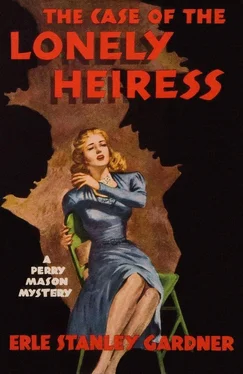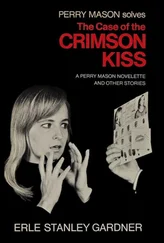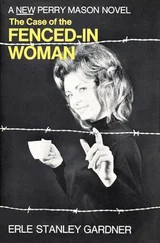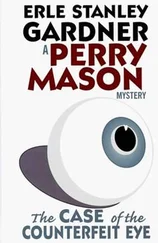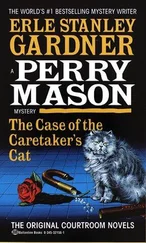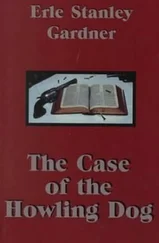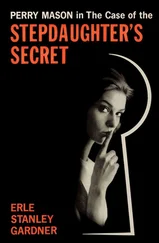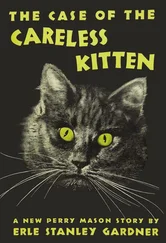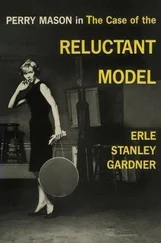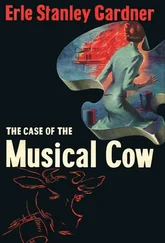“Lieutenant Tragg, I’ll ask you if you ever saw this knife before.”
“Yes, I have seen that knife before. I can identify it because it has my initials scratched on the handle. I found that knife under the floor mat in the trunk compartment of the defendant’s automobile. At the time I found it, it was in exactly the same condition as it now appears, except that some of the encrusted blood stains on the blade have been subjected to chemical tests in the police laboratory. This has somewhat altered their appearance. There is also a slight change in the appearance of the knife, in that the handle and portions of the blade have been dusted with powder for the purpose of developing latent fingerprints.”
“Were any developed?”
“No, sir, none were developed. The handle had been very carefully wiped, so as to remove all traces of fingerprints.”
“That’s a conclusion of the witness,” Mason protested.
Lieutenant Tragg smiled, and said, “Well, I will put it this way: The handle was absolutely devoid of all latent fingerprints, all prints of any sort. Not even the faintest smudge.” He added triumphantly, “And, as a man who has had considerable experience with homicide cases and the development of latent fingerprints, I know that such a condition couldn’t possibly have existed unless the handle had been very carefully wiped.”
“Are you,” Mason asked Hanover, “preparing to introduce this knife in evidence?”
“Exactly,” the deputy district attorney said.
“Under the circumstances,” Mason announced, “there will be no objection. Go ahead and put it in evidence.”
Judge Osborn seemed frankly puzzled. “Of course,” he pointed out, “there has been as yet no attempt to show that this is the so-called murder weapon. While it is true that the decedent apparently died from a stab wound, and I gather that the dimensions of the knife are approximately similar to the width of the stab wound, there is as yet no other evidence.”
“Exactly,” Hanover said. “I have other evidence, Your Honor, which I would wish to introduce.”
“But,” Mason interpolated, “the deputy district attorney wishes to introduce this knife in evidence. It has been identified as the knife which was found in the defendant’s automobile, and I have no objection to it being received in evidence.”
“As the murder weapon?” Hanover asked.
Mason’s smile was frosty. “I have no objection to it being received in evidence as a knife which was found in the back of the defendant’s automobile.”
“Very well,” Hanover snapped, “introduce it on that basis and we’ll connect it up later.”
Judge Osborn pursed his lips, as though debating whether to make some comment, finally decided against it and said, “Very well, the knife will be received in evidence and marked with the appropriate exhibit number by the clerk. Proceed, gentlemen.”
“Now then, Your Honor,” Hanover said, “I’d like to excuse Mr. Tragg for a moment, put another witness on the stand and then recall Lieutenant Tragg.”
“No objection,” Mason said.
Tragg left the stand.
“Call Sergeant Holcomb,” Hanover said.
Sergeant Holcomb was sworn, testified as to his name, age, address and occupation, then settled back comfortably in the witness chair. “You’re acquainted with the defendant, Marilyn Marlow?” Hanover asked.
“Yes, sir.”
“And did you have any conversation with her concerning her relations with Rose Keeling? Now that’s a preliminary question, Sergeant. Just answer it ‘yes’ or ‘no.’ ”
“Yes.”
“When was that?”
“On the seventeenth of this month.”
“That was the date the body of Rose Keeling was discovered in her flat?”
“That’s right.”
“Where did this conversation take place?”
“In the office of the Homicide Squad at police headquarters.”
“At that time did the defendant, Marilyn Marlow, make any statements to you as to whether she had been in the flat of Rose Keeling at any time during the day?”
“She did.”
“What did she say?”
“Just a moment,” Mason said. “The proper foundation has not been laid. There has been no statement on the part of this witness as to whether or not this statement was a free and voluntary statement or whether it was obtained by duress.”
“It’s not necessary to lay that foundation, Your Honor,” Hanover said. “We’re not asking for a confession. We’re asking only for an admission. It is a well-settled rule that an admission against interest does not necessarily require that it was made voluntarily.”
“Nevertheless,” Mason said, “I think that what Counsel is claiming as an admission affects the rights of the defendant so that I am entitled to find out first if it was a free and voluntary statement. Your Honor, may I ask a few questions of Sergeant Holcomb on this point?”
“Very well, go ahead,” Judge Osborn said.
“There were several officers present when this statement was made?” Mason asked Sergeant Holcomb.
“That’s right.”
“These officers were grouped in a circle around the defendant?”
“They were around where they could hear.”
“How was the room illuminated?”
“With electric lights,” Sergeant Holcomb said. “We quit using kerosene before I came on the job.”
A ripple of merriment sounded from the spectators.
“Was there one big light in the room?”
“Yes.”
“And that was directed full on the face of the defendant?”
Sergeant Holcomb said, “You can’t illuminate a room and not have it so that some light doesn’t shine on the face of the defendant. We try to give ’em service but we can’t give ’em that much service.”
People in the courtroom tittered.
“Wasn’t that light so arranged that it concentrated its rays upon the face of the defendant?”
“The defendant was just sitting there,” Sergeant Holcomb said.
“Facing the light?”
“That’s right.”
“Who was questioning the defendant?”
“I was.”
“And didn’t some of the others question her?”
"Some of them, yes.”
“Didn’t all of them question her?”
“Well, they may have.”
“During the time that the defendant was in that room, did some other person enter the room?”
“How do I know? I didn’t keep track of everybody that came and went. Perhaps they did. Perhaps they didn’t.”
“Did anyone enter that room at your suggestion?”
“Perhaps.”
“Didn’t you ask a young woman to come to that room?”
“I think maybe I did.”
“And did you ask that woman to identify the defendant?”
Sergeant Holcomb shifted his position. “Well, yes.”
“Had that woman actually ever seen the defendant before?”
“I don’t know. I can’t tell what people that woman had seen and what people she hadn’t seen.”
“You instructed that woman before she entered the room to come in the door, to point at the defendant and say, ‘That’s the woman,’ or words to that effect?”
“I told her to come in and identify the woman.”
“Who was this person whom you told to enter the room and identify the defendant?”
“A night stenographer in the traffic department.”
“And sometime later you signaled Lieutenant Tragg to come in?”
“I may have.”
“And resorted to a prearranged act by which he dispersed all the officers and took the defendant into his office?”
“Well, what if he did?”
Mason said, “There you are, Your Honor, a typical case of a police third degree.”
“I don’t think I’ll entertain evidence of a confession,” Judge Osborn said, “but I will receive evidence as to an admission. Go ahead, Mr. Hanover.”
Читать дальше
